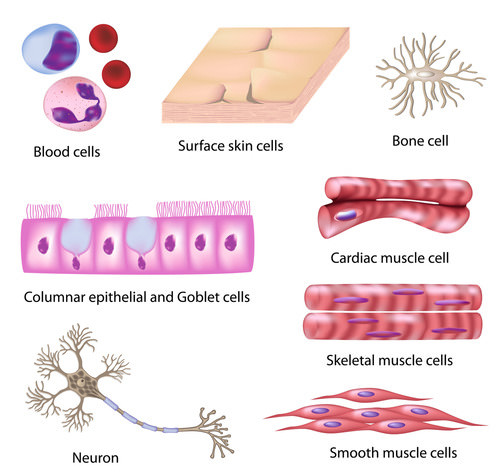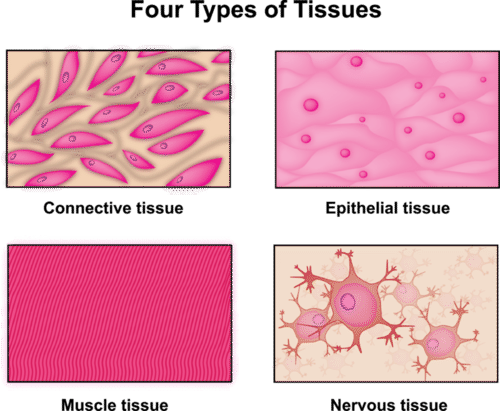READ: Biological Levels of Organization
| Site: | Mountain Heights Academy OER |
| Course: | Biology Q2 |
| Book: | READ: Biological Levels of Organization |
| Printed by: | Guest user |
| Date: | Monday, 28 July 2025, 10:11 PM |
How does the body work?
How is the human body similar to a well-tuned machine?
Over and over, the human body is compared to a complex piece of machinery. Like any common machine, the human body is composed of a variety of parts, each working separately, but also working together.
Cells
Cells are the most basic units of life in your body, and each cell is specialized, with a specific function. Nerve cells transmit electrical messages around the body, and white blood cells attack invading bacteria throughout the body. Other cells include specialized cells in the kidney (such as kidney glomerulus parietal cells), brain (such as astrocytes), stomach (such as parietal cells), and muscles (such as red and white skeletal muscle fibers). Cells group together to form tissues; different tissues work together to form organs. This grouping of cells and tissues is referred to as levels of organization. Complex multicellular organisms, which include flatworms and humans, have different levels of organization. The human body's levels begin with cells and conclude with the entire organism.
Tissues
Tissues
A tissue is a group of connected cells that have a similar function within an organism. The simplest living, multicellular organisms, sponges, are made of many specialized types of cells that work together for a common goal. Such cell types include digestive cells, tubular pore cells, and epidermal cells. Though the different cell types create a large organized, multicellular structure—the visible sponge—they are not organized into true tissues. If a sponge is broken up by passing it through a sieve, the sponge will reform on the other side.
More complex organisms, such as jellyfish, coral, and sea anemones, have a tissue level of organization. For example, jellyfish have tissues that have separate protective, digestive, and sensory functions. There are four basic types of tissues in the bodies of all animals including the human body. These make up all the organs, structures, and other contents of the body. Figure below shows an example of each tissue type. The four basic types of tissues are epithelial, muscle, nervous, and connective.
Epithelial tissue is made up of a layer or layers of tightly packed cells that line the surfaces of the body. The largest example of epithelial tissue (also the largest organ in the human body) is the skin. Epithelial tissue has multiple functions, but it serves primarily to protect, absorb, and secrete. As you probably already know, our skin organ covers our entire body and protects underlying tissues from bacteria, chemicals, and other injury. Epithelial cells also line the small intestine where they absorb nutrients, and similar cells in the glands secrete enzymes and hormones.
Muscle tissue encompasses not only the muscles, such as those in our legs or fingers, that we actively control, but also the tissue that forms most of our internal organs. There are three types of muscle tissue: skeletal, cardiac, and smooth. Skeletal muscle tissue forms what we think of as our muscles; it is attached to our bones by our tendons and can be relaxed or contracted voluntarily. Similar in structure to skeletal muscle, cardiac muscle is found exclusively in the walls of the heart. The major difference, however, is that cardiac muscle is involuntary and cannot be actively controlled. Similarly, smooth muscle, which forms the muscle layers in internal organs such as the digestive tract and bladder, is an involuntary tissue. Smooth muscle tissue controls slow involuntary movements such as stomach wall contractions and the contractions of arteries to regulate blood flow.
Nervous tissue is made up of the nerve cells (neurons) that form the nervous system, including the brain and spinal cord. These cells are especially responsive to stimuli, allowing nervous tissue to transmit stimuli from the brain to the body extremely rapidly.
Connective tissue connects, supports, or separates other tissues and organs. Connective tissue proper, a form of connective tissue, can be either loose or dense. Adipose tissue, or fat, is loose connective tissue, while tendons and ligaments, composed of collagen, are examples of dense connective tissue. Other forms of connective tissue include blood (fluid connective tissue) and cartilage and bone (both forms of supporting connective tissue).
Groups of Tissues Form Organs
Organs
Organs are the next level of organization in the body. An organ is a structure made of two or more tissues that work together for a common purpose. Skin, the largest organ in the body, is shown in Figure below. Organs can be as primitive as the brain of a flatworm (a group of nerve cells), as large as the stem of a sequoia (up to 90 meters (300 feet) in height), or as complex as a human liver. The human body has many different organs including the heart, the kidneys, the pancreas, and the skin. Two or all of the tissue types can be found in each organ. Organs inside the body are called internal organs.
Organ Systems
The most complex organisms have organ systems. An organ system is a group of organs that act together to carry out complex, interrelated functions, with each organ focusing on a subset of the task. For example, the human digestive system is an organ system in which the mouth and esophagus ingest food, the stomach crushes and liquefies it, the pancreas and gall bladder make and release digestive enzymes, and the intestines absorb nutrients into the blood. An organ can be part of more than one organ system. For example, the ovaries produce hormones, which makes them a part of the endocrine system; the ovaries also make eggs, which makes them a part of the reproductive system as well. One of the most important functions of organ systems is to provide cells with oxygen and nutrients and to remove toxic waste products such as carbon dioxide. A number of organ systems, including the cardiovascular and respiratory systems, work together to do this.



